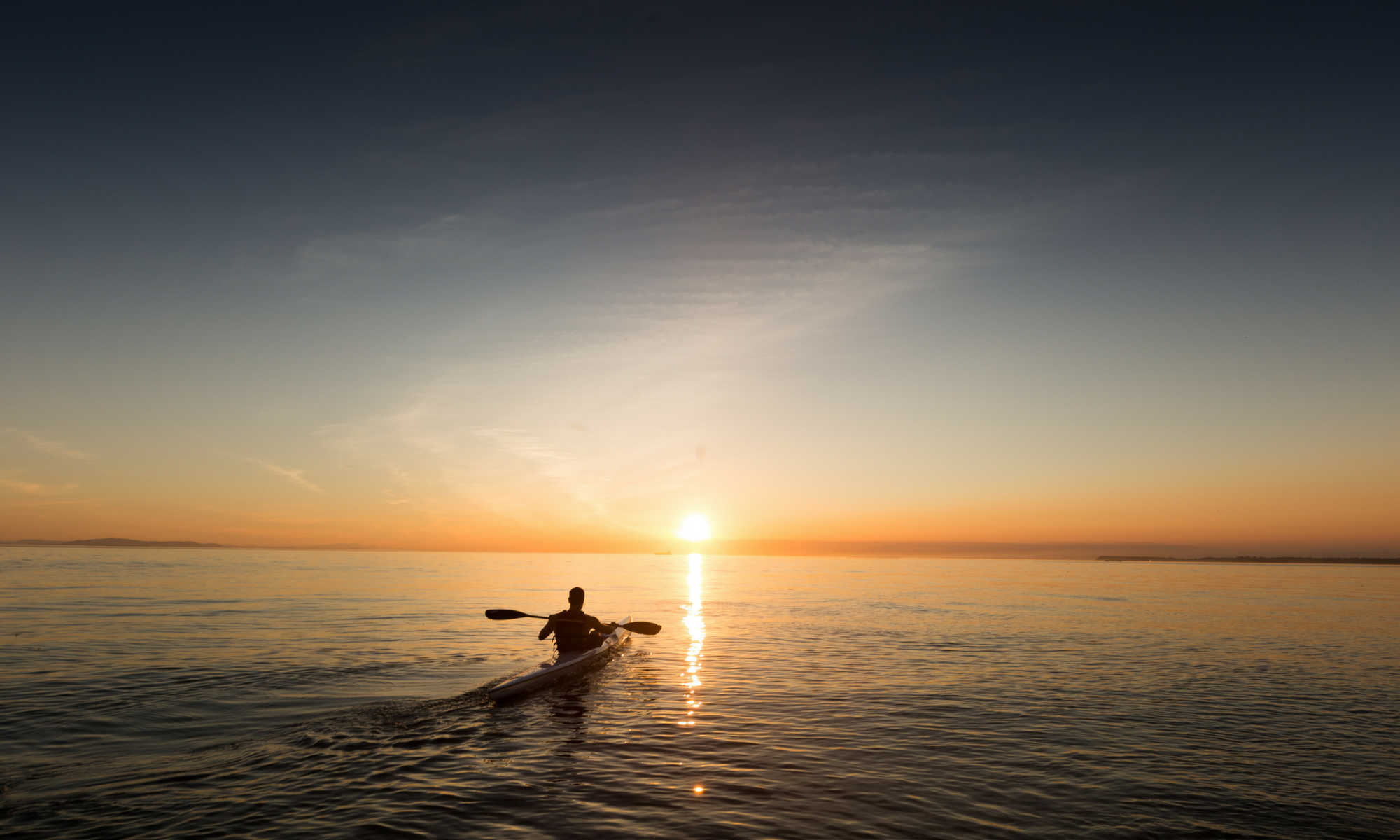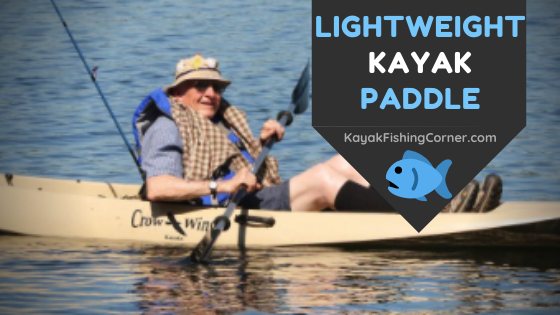Jump Ahead To:
LIGHTWEIGHT KAYAK PADDLE: INTRO
Before I bought my own lightweight kayak paddle, every time I went on a prolonged kayak fishing trip, I used to feel the full weight of my paddle. My wrists would be aching from the very moment I got home. I am glad I switched to a lighter version of paddle and I want to help you learn how to make the switch as well! Ready to get started?
Lightweight Kayak Paddle: Overview

Please note: This post contains affiliate links. An affiliate link means that we may earn advertising/referral fees if you make a purchase through our links.
Shortcut to our favorite Lightweight Kayak Paddle
I wrote this article to highlight everything you need to know to become informed about buying and using a lightweight kayak paddle. For the sake of organization, I’ve decided to break this article into various sections. That will make it easier to skim through the article and jump right to the section you want to read. The faster you read the article, the faster you can get back to kayak fishing (and you put on your kayak fishing life jacket, of course)!
To begin, I’ve presented a section covering basic information about a standard lightweight kayak paddle. Without an understanding of the basics, the rest of this post won’t be of much help to you! Just below that, I’ve included a checklist to get you started using your lightweight kayak paddle correctly.
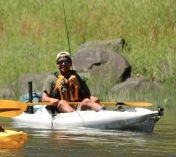
I’ve also listed down all the features you need to look for when evaluating one lightweight kayak paddle against the next. With so many different models on the market, you’ll want to know which features matter and which features don’t. After that, I’ve included a link to my favorite lightweight kayak paddle – its been with me for 3 fishing seasons at this point. It is just a personal favorite, but it meets all the criteria I mentioned in the previous section.
And finally, I’ve compiled my thoughts in the “My Own Experience” section. I like to learn from the experiences of others – hopefully you can learn a thing or two from my own! This area of this article includes thorough review of the pros and cons of this particular model and you can see why I feel the way that I do about it.
Parts of a Kayak Fishing Paddle
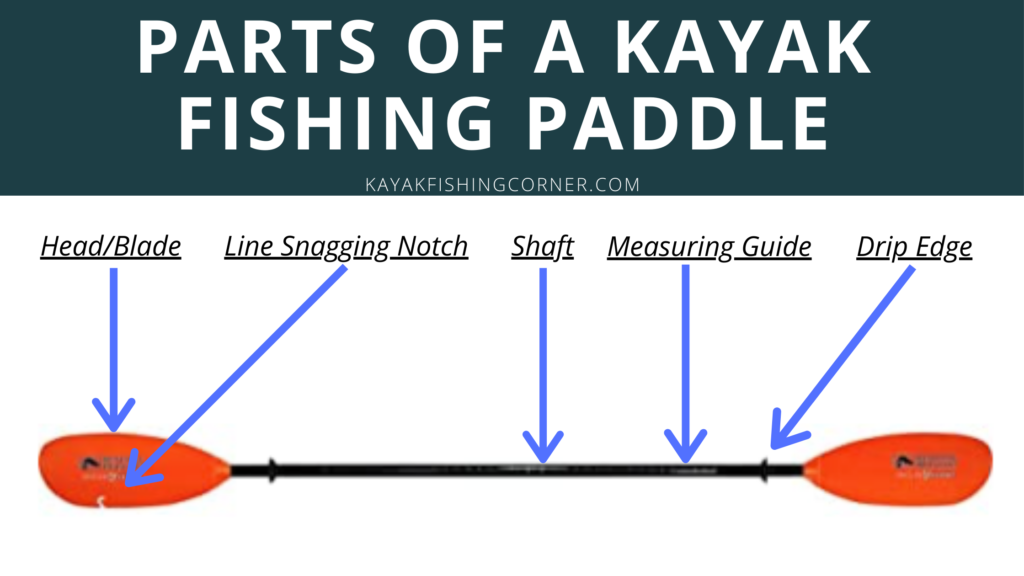
Lightweight Kayak Paddle – The Basics

Please Note: As an Amazon Associate, I earn from qualifying purchases.
Kayak fishing paddles are different from boat or canoe paddles. Some people don’t realize that, but the distinction is incredibly important! With a kayak fishing paddle, you need to paddle on one side, then paddle on the other. Doing so will keep you heading in a straight line! It’s not all that complicated, but for people who haven’t ever rowed a boat, much less a kayak, kayak paddles can be tough to understand.
That is because, unlike in rowboats or kayak fishing pedal kayaks, you need to pick up the entire paddle and shift its weight to the other side. And if the kayak fishing paddle is heavy (or you have weak hands or grip strength), it can take ages to master the proper technique!
Luckily, even if you are on the petite side, you can ease the stress by looking for a lightweight kayak paddle! It is perhaps the first thing that you should check for when you’re buying your kayak fishing gear. After all, with no paddle, you aren’t going to be able to get out to the fish in the first place.
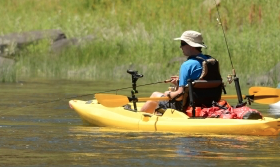
Concerning this, there are two major things to look for: The Shaft Material and The Blades. Not familiar with these pieces? The shaft is the main handle of the paddle, and the blade is the plastic or nylon end of the shaft. When talking about weight, the materials that go into the shaft and blades should be the first consideration. However, they aren’t the only one…
For instance, the design of the blade will dictate how much force will be required for you to displace the water (after all, that’s exactly what you are doing when paddling, displacing water). A smartly designed and lightweight blade will significantly reduce the force with which you need to paddle. The design of the shaft will also factor into how comfortable it is to grasp and use. The more comfortable the shaft, the longer your hands will be able to grasp it and the harder you’ll be able to stroke it!!!!
While you are here, make sure you know how the importance of getting the correct kayak paddle length! This is extremely important when evaluating kayak paddles for beginners!
How to Use a Lightweight Kayak Paddle:

Since paddling a fishing kayak isn’t much like paddling a canoe or paddle boat, it can take some time to master. Here’s a rundown on how to effectively use a lightweight kayak paddle to propel you towards your desired fishing location:
- Unbox the paddles and read through the instruction manual thoroughly.
- Identify the parts, including the shafts and the blades.
- Locate the ferrule at the end of the shaft.
- Attach the blades to the shaft, reading the instructions.
- Hold the paddle directly above your head.
- Place your hands in such a way that the elbows are at a right (90 degrees) angle to the shaft.
- There are three main techniques for kayaking: forwards, reverse, and sweep stroke.
- For the forward stroke, submerge the blade of the paddle near your toes.
- Then pull it back towards your hips, pulling it out of the water as it goes behind you.
- Do not pull the blade to the back of the boat.
- Perform the same stroke motion with the other side.
- For the sweep stroke (used in making turns), place the blade near your toes.
- Then draw a semicircle along the length of the boat until the blade reaches the end of the boat.
- For the backward stroke, simply place the blade at your hips and then push it to your toes.
- This type of stoke is used in reverse.
- Keep practicing, first on dry ground, and then on your kayak with the supervision of an experienced person.
- Store your paddle in a dry, safe area, away from exposure to sunlight (like inside your kayak cover).
Lightweight Kayak Paddles – Important Features:
Material of the Blade:
Plastic is perhaps the best material for kayak fishing paddles. It’s lightweight, durable, cheap, and does not get hot in the sun. However, it will start to degrade and possibly melt when left out in the sun for too long, so be cautious. Also, it’s a flexible material, so it tends to not resist water pressure, allowing you to paddle more efficiently.

Fiberglass is another alternative that can resist both water and air pressure, which is a good quality depending on the condition of the water your are paddling in. However, its durability is not guaranteed as it can damage quite a bit more easily than the plastic competitors. Carbon-fiber is another lightweight material, but it’s too expensive for most levels of kayak fishermen (some professionals do use carbon-fiber, however). If you can get your hands on one, it can provide high marks in terms of water and air dynamics.
Material of the Shaft:
The shaft is normally made from carbon or aluminum. Aluminum is the lighter of the two and is more durable as compared to carbon. While carbon and aluminum are the two most popular, you can also find a quality lightweight kayak paddle in carbon-fiber or fiberglass. These are even better than aluminum, but they will cost you more!!! We think the increased expense is worth it in terms of performance, but you’ll need to be abundantly careful to ensure that you don’t damage the paddle and incur costly repairs (or even replacement).
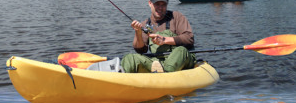
Water Dynamics:
When paddling, it is preferred that the blade must not resist the water flow. If you have low water dynamics, you need more force to push or pull through the water. This will tire you out more quickly and lead to less fishing time. Some blades are uneven, with a slight angle at the tip. This is a marvel of engineering! Why are they angled? So when you hold the paddles at an angle to the kayak, the tips lie flat on the water! Again, its all about paddling efficiency. Also, KFC suggest that you look for a narrow blade. A narrow blade will minimize force and allows for prolonged paddling.
Air Dynamics:
A paddle with heightened air dynamics in the design of the blade will cut through the air without creating increased resistance. In this case, finding a fishing paddle with “feathering” is your best option. Wait, “feathering”, I thought we were talking about kayaks and fish, not birds and feathers! For those of you who don’t know, feathering is the phrase used to describe when one blade rotation is at least 90 degrees while the other blade lays flat. See, nothing fancy just a “twisted” blade orientation. In this way, when one blade is submerged, the other cuts through the air, reducing any air resistance. Pretty smart huh?
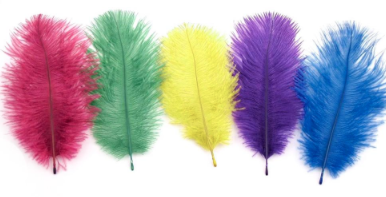
Paddle Size/Length:
Lastly, the length of the paddle will dictate how easy it is to use and maneuver. Obtaining a properly sized lightweight kayak paddle is dependent upon being honest wth the dimensions of your fishing kayak, as well as your own! Yes, your own height! For this, measure the width of your kayak and your height. If you’re under 5 foot 5 inches, a range of 210 to 240 cm paddle length is optimal for you. If you’re taller than that but shorter than 6 feet, 220-250 cm is the range. And if you’re taller than 6 feet, the range can go as high as 260 cm, depending on your kayak’s width, of course. Remember, be honest in your measurements. Your shoulders, forearms, wrists and hands will thank you for it!
Buy The Best Lightweight Kayak Paddle:
In my experience, and based upon discussions with others and significant third party research, the model showcased above is the best lightweight paddle on the market – especially for kayak fishermen!. It has all the features that make a kayak paddle lightweight and easy to stroke. This paddle is 224 cm long and comes in four parts for higher storage capacity.
The shaft of this paddle is made from an aluminum alloy. As discussed before, aluminum is the lightest and durable material for shafts. It can be hollowed for minimum weight. I think it removes a lot of weight from the shaft that other products tend to ignore.
What’s more? It is a 4-piece paddle that means the shaft can be broken into two pieces, allowing for a minimum length of 60 cm. So you can keep it tucked away, and it’s way more portable than a regular 3-piece shaft. When fully assembled, the shaft is 224 cm long, which will fit most standard size kayaks. This paddle is great for backpacking as well. Just break it down and store in, or attach to, your standard size carry pack.

Another reason why I recommend it is the extreme affordability. Remember, not all kayak fishermen are professionals, especially in terms of correct paddle usage. Your paddle is going to take some dents and dings. Don’t buy the most expensive model out there until you’ve truly mastered your strokes! Oh and, yes, before you ask, there are lighter fishing paddles on the market, but most of them are expensive and end up breaking after a few significant bumps and bangs!
KFC likes that this model is made from polypropylene (a fancy way of saying plastic). I already pointed out that plastic can melt, so you won’t want to leave these paddles out in the direct and hot sun for extended periods of time.
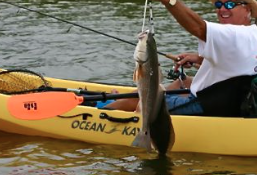
Also, the blades are flat and symmetric (not feathered, as earlier described). There is a rib down the middle that helps guide water over the two halves. But if the blade were asymmetric, it would cut through the water more swiftly. However, this problem can be mitigated by slightly turning your wrist when paddling, artificially creating the desired 90 degree angle!
I’ve used both types of paddles (feathered and non-feathered), and the difference isn’t all that noticeable, especially if you consider the aluminum body.
One other thing you should note is the flexibility of the blades. They are very thin and tough. There’s a reason why it’s called the Ultralite. The paddle weighs only 1.6 pounds. Yes – that’s not a typo. These things are exceptionally light weight. And since you’ll be using both hands to row it, I don’t see how this could be heavy at all. It feels like lifting a feather. And that’s the main reason I chose this as the best lightweight kayak paddle, despite the lack of feathering!!
Lightweight Kayak Paddle: My Experience

My personal experience has been good with this paddle so far – and I am several fishing seasons in at this point. It hasn’t stained or become dirty in all the time I’ve used it. I found that the ferrule where all the parts connect is air-tight, so there’s no way any weed or dirt can get in between it.
As for performance, the blades are working perfectly fine. The paddle is so lightweight, I barely feel it. Occasionally, I may feel some friction, but the narrow blade can cut through the water just fine. While feathering would be nice, I actually perfected the “90 degree turn” pretty quickly, so that problem quickly disappeared. Weighing only 1.6lbs, its easy for me to rotate my wrists to the desired angle.
I also really like that this particular fishing kayak paddle collapses into four pieces. This makes for a really efficient backpack outing if you are one who hikes your kayak fishing location (in which case you should also look into getting a portable kayak or lightweight fishing kayak). Keep in mind that this paddle is a specialized one in terms of its light weight. It’s not made to withstand the torrents of whitewater. Better to use this paddle if you are fishing flatwaters and low current streams.
To summarize all the goods and bads I noticed when I using this particular paddle during my fishing outings, here’s a handy list:
Pros:
- No stress on the wrists.
- Cuts through the water just fine.
- Doesn’t stain or acquire impurities.
- Doesn’t catch debris in the ferrule.
- Easier backpacking.
- Works on any standard size of the kayak.
Cons:
- Not for taller than 6 ft.
- Not made to withstand high currents.
- No “feathering” (can be mitigated by proper paddling technique)
Conclusion

So I hope this post helped you learn all about lightweight kayak paddles. They are a crucial piece of gear for a kayak fishermen of any level of skill or experience. Who would’ve guessed that the weight isn’t the only thing that dictates whether the paddle is easy to use? Remember, the shape of the blade should be considered, as well as the material of the shaft!
I pointed out all the good things that a lightweight kayak paddle must-have. But a true lightweight paddle is light on the wallet as well. Weighing only 1.6 pounds, and being the best choice for backpacking, you understand why I am so fond of the showcased model of paddle!!
Comments
How do you propel your fishing kayak while out on the water? Do you use the traditional paddling method? Have you ever tried a lightweight kayak paddle? Did you notice that you were able to stay on the water for longer periods of time because of its light weight? Did you experience the increased maneuverability that we mention above? Please comment below and share your experience with us! We love interacting with this kayak fishing community and we read and reply to every comment! Good luck out there!!!
